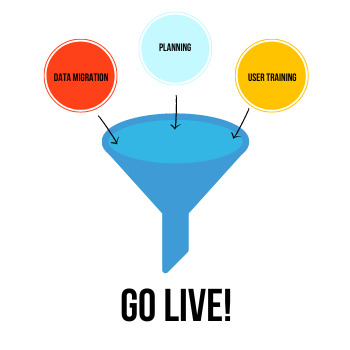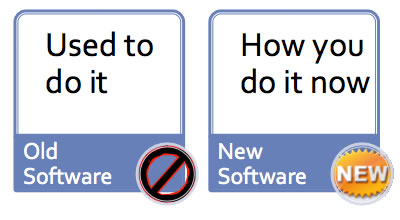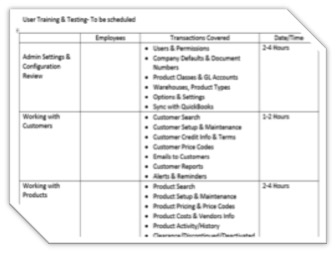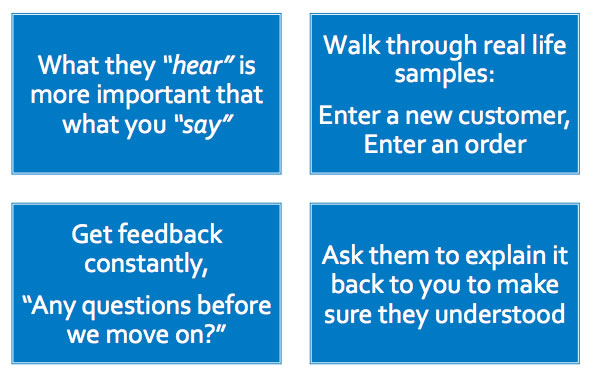3 keys to successful software implementation
Built For


As Jessie puts it, “Keep it simple,” and she did by breaking the software implementation process into three key phases: Planning, Data migration and User training.
Key 1: Planning, workflow, operations, system design
The longest and most important phase is the planning phase.
During the planning phase, expectations are set, project champions and detractors are identified, the discovery process continues and workflow processes are developed.
Setting expectations is critical for success

This is the point in the process where everyone needs to understand what the software can and can’t do.
Decisions on the features and modules that will be deployed are made & prioritized and the associated processes & procedures should be examined to ensure project success.
As the vision of the software in use begins to come into focus, success criteria can be established. It is hard to hit a goal that isn’t established, so the question, “What does success look like?” should be clearly defined.
The software implementation manager will outline a detailed project plan that begins with a kickoff meeting to explain the scope of work, project requirements, estimated time to complete the implementation, and establish project milestones.
Identifying project champions and detractors

Software implementations require change and some people respond better to change than others.
As with almost all projects, there will be some that jump on board immediately and some that will do their best to be a roadblock.
Identifying those from each group is an important part of the software implementation process.
The champions will be the group that makes things happen. They will be the ones that do the work and will be the evangelists, working to convince the entire team that the future will be better following the implementation of the new software.
From the champion group, finding one “super user” that can provide on site support after go live and positive support during the project can greatly assist as the implementation moves forward.
And then, there’s the detractors. They’ll drag their feet. They’ll be the ones saying, “But, we’ve always done it this way.” They don’t like change and will let anyone that will listen know this is a bad idea.
Hear them out, but don’t let them derail the project. Engage them in a part of the project that will provide them an early, small win. Hopefully, as the implementation continues, they’ll come around.
Additional discovery

While some level of discovery occurred during the software selection process, additional detailed information is required during the software implementation process.
A thorough, detailed dive into the business details, uncovering samples of forms, reports, processes and special situations, enables a complete picture of the existing business situation to be developed and provides the information needed to determine where the software can improve daily functions throughout the business.
How work will flow with the new software in place
Workflow development involves assessing the information gathered and determining how work should occur once the software has been implemented. Keeping it as simple is almost always better, with an eye on staffing and actual needs as the workflows are developed.

Once the new processes are mapped out, they should be tested in a sandbox or test environment. Flow charts with step-by-step lists will ensure details aren’t missed and can also be used during the training process later.
At the end of the planning phase, everyone should be on the same page, with a thorough understanding of how they are going to use the new software and everyone should be confident it’s going to work for them.
Key 2: Data migration

Migrating the data is the technical phase of the project.
The old adage – garbage in, garbage out – should be top of mind during this phase.
Before data migration can begin, decisions to key questions must be answered, such as…
- What data will and won’t be transferred?
- How will the data be transferred?
Import/Export Formatting vs. Direct Conversion Tools - When will the data be transferred?
On Go Live Day, Before Go Live (what about updates & changes?) - Who is going to transfer the data?
- Is there data from other systems that will need to be incorporated too?
- Are there custom fields or unique requirements?
3 rules are crucial during the data migration phase
- If you are not comfortable, don’t do it.
- Backup everything
- Verify everything with data owner

Numerous configuration questions will need to be addressed during the data migration phase ranging from which features should be turned on day 1 to setting user permissions to customization options. Mapping between the systems also occurs at this point.
Once the mapping and configurations are in place, options are tested in a sandbox/test environment.
Following thorough and complete testing, a roll-back plan is created just in case there is an issue during the migration.
Once complete, one last check that everything is backed up occurs, then the project is ready for migration.
Key 3: User training

Prior to go live, training must be developed and a training schedule should be established.
Sessions can include remote, on site and pre-recorded sessions. The “super user” identified in the planning process should attend all trainings.
When developing the user training content, use workflows from the planning phase to identify training topics, and create “cheat sheets”, handouts and takeaways with screen shots that can be used following the training.
When conducting the user training, things to remember…

Go live

The day you flip the switch and go live should be coordinated to cause minimal work distraction.
Timing wise, if possible the software go live should occur over a weekend and at the end of an accounting period.
At go live, everyone should know what to expect, know who is going to do what, and know how to use the new software.
Ongoing success
Following the software implementation, there will be questions and, as the software becomes a part of normal business routines, ongoing support needs can include:
- Additional training on how to use the new system
- Tech support & troubleshooting
- New customizations such as reports
- New business requirements
- New features added such as EDI, barcoding, etc.

About Jessie Rushing
Jessie Rushing owns JR Consulting, a software consulting practice in Simi Valley, California.
JR Consulting’s services include inventory management consulting, QuickBooks data services & custom software development, and QuickBooks utilities. JR Consulting is a Gold Certified Acctivate Consulting Partner.
Call us at 817-870-1311






